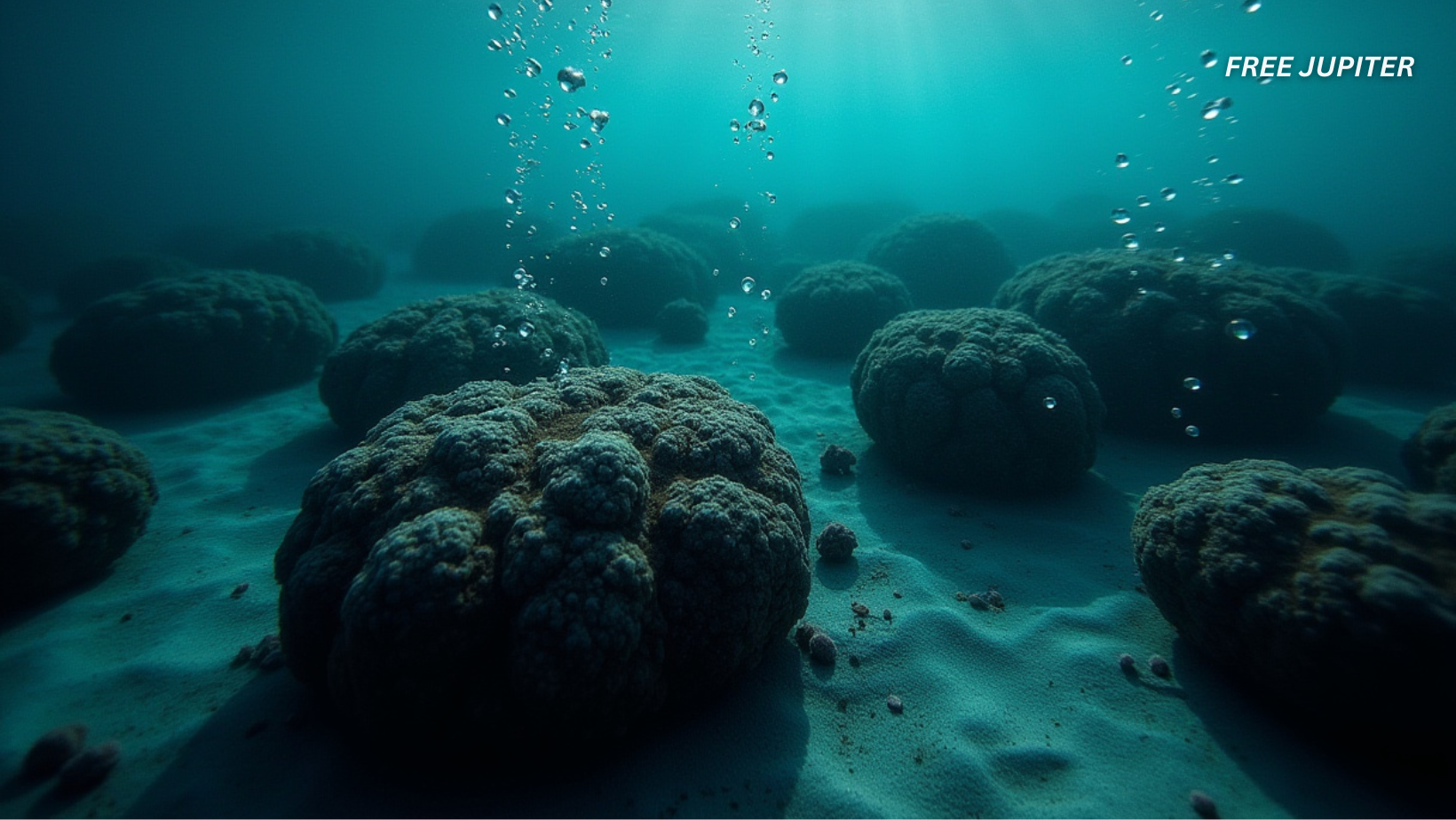Far beneath the surface of the Pacific Ocean, hidden between the Hawaiian Islands and the western coastline of Mexico, lies an expansive underwater region few have explored in depth. Known as the Clarion-Clipperton Zone (CCZ), this mysterious part of the ocean floor spans roughly 4.5 million square kilometers. It rests within a vast abyssal plain, tucked quietly between two major fracture zones—the Clarion and the Clipperton.
Though largely uninhabited by humans, the CCZ is far from lifeless. A diverse array of marine species thrives in its darkness. However, what has drawn the world’s attention to this undersea landscape isn’t just the vibrant ecosystem it supports—it’s the strange, metallic rocks scattered across the seafloor. These potato-sized objects, known as polymetallic nodules, have become the centerpiece of a rapidly intensifying global debate.
These nodules are not just lifeless lumps of rock. Each one is packed with high-value metals—copper, manganese, cobalt, nickel, and zinc among them. These elements are considered crucial for building the next generation of green technology. They power electric vehicle batteries, solar panels, and energy storage systems. Due to this, they’ve earned a compelling nickname among mining companies: “batteries in a rock.”
Yet, as it turns out, these peculiar rocks might be hiding an even more surprising secret.
Read more: Scientists Have Discovered A Mysterious ‘Golden Orb’ at the Bottom of the Ocean
A Hidden Force in the Deep
Recent scientific findings have revealed something unprecedented. At a staggering depth of nearly 4,000 meters, far beyond the reach of sunlight, a form of oxygen is being generated. And strangely enough, it’s being produced by these very same polymetallic nodules. This oxygen is not created through the traditional means of photosynthesis, which requires sunlight. Instead, it is formed in complete darkness—a phenomenon researchers are now calling “dark oxygen.”
The implications of this discovery could stretch far beyond marine geology or battery manufacturing. If confirmed, it could reshape the very understanding of how life formed on Earth. Even more intriguingly, it might offer clues as to how life could begin on other celestial bodies such as Europa or Enceladus, moons believed to harbor subsurface oceans.
\Published in the prestigious journal Nature Geoscience, the study was led by Dr. Andrew Sweetman, a deep-sea ecologist associated with the Scottish Association for Marine Science. In a statement, Sweetman posed a question that challenges centuries of scientific belief: “If oxygen is being produced in the deep ocean, in the absence of light, should we re-examine where aerobic life might have originated?”
For decades, it had been believed that Earth’s oxygen-rich atmosphere was made possible by photosynthetic microorganisms, like cyanobacteria. These organisms, bathed in sunlight, were thought to have transformed the planet’s early environment. But this discovery suggests another path—one where oxygen could arise in lightless, high-pressure environments at the ocean’s floor.
Read more: The Discovery Of A 1,200-Year-Old Ship ‘Laden With Cargo’ Is Rewriting The History Books
A Long Road to Revelation
The journey toward uncovering this dark oxygen began years ago. Sweetman had been studying oxygen consumption at various ocean depths, and during an expedition in 2013, data gathered from the CCZ showed something unexpected. Instead of oxygen levels decreasing as expected, the sensors indicated a slight increase.
At the time, it had been assumed that the instruments were faulty. No plausible explanation could be provided for such a finding. However, the anomaly refused to disappear. Later studies yielded similar results. Something in the abyssal plain was producing oxygen where no light could reach.
It was a mystery too curious to ignore.
Sweetman recalled the industry’s term for polymetallic nodules—“batteries in a rock”—and began to wonder whether these minerals could act as natural geobatteries. Perhaps the minerals within the nodules were engaging in a process similar to electrolysis, splitting water molecules into hydrogen and oxygen.
To explore this theory, Sweetman and his team set up controlled experiments that replicated the environmental conditions found in the CCZ. All microbial life was neutralized using mercury chloride, removing the possibility that bacteria or archaea were responsible for the oxygen production.
What they discovered stunned them. Even in a sterile environment, oxygen levels continued to rise.
As reported by Scientific American, the nodules themselves were found to carry an electric charge—about 0.95 volts. It’s believed this charge is created naturally as various metal deposits accumulate unevenly across the nodule’s surface. This slow buildup of electrochemical energy is strong enough to split seawater molecules into hydrogen and oxygen.
In essence, the nodules were functioning like low-powered batteries on the seafloor—harvesting energy and releasing oxygen in complete darkness.
The Ethical Dilemma of Deep-Sea Mining
With these revelations, a new layer has been added to the already heated discussion about deep-sea mining. Companies like The Metals Company have been campaigning for large-scale extraction of polymetallic nodules. Their argument hinges on the urgent demand for sustainable energy materials. But now, with evidence that these nodules are doing more than just storing metals—potentially sustaining life through oxygen production—the stakes have risen dramatically.
As of now, more than 25 countries have expressed support for a pause or moratorium on deep-sea mining. They are urging the International Seabed Authority (ISA) to hold off on approving commercial extraction until further studies are conducted.
The concern isn’t unwarranted. Earth’s oceans are already suffering from various environmental crises—acidification, warming, pollution, and the ongoing depletion of oxygen. If these nodules are indeed contributing to local oxygen levels, removing them could have unintended consequences for marine life. Consequences that may not become fully apparent until it’s too late.
Dr. Lisa Levin, a biological oceanographer from Scripps Institution of Oceanography, commented on the study despite not being directly involved. Speaking on behalf of the Deep Sea Conservation Coalition, she emphasized the importance of such findings.
“This is precisely why the deep sea should be considered a frontier,” she said. “It’s a place where new and unexpected processes continue to emerge. The fact that polymetallic nodules are producing oxygen at the seafloor introduces an entirely new ecosystem function. Before irreversible damage is done through mining, this must be thoroughly studied.”
Redefining Life’s Origins
Beyond policy debates, the implications of this discovery could echo across the fields of astrobiology and evolutionary science. If oxygen can be produced chemically in deep, lightless environments, then it opens up the possibility that life could originate—and thrive—under similarly extreme conditions elsewhere in the universe.
Saturn’s moon Enceladus, and Jupiter’s moon Europa, both have subsurface oceans concealed beneath thick ice shells. For years, scientists have speculated about whether life might exist in these alien seas. Until now, one of the largest obstacles was the assumed lack of oxygen. This research challenges that assumption.
Could metal-rich seabeds on other worlds be undergoing similar processes? Could “dark oxygen” be the missing ingredient needed to support life beyond Earth?
These are the questions now being asked by researchers in planetary science and astrobiology alike.
Read more: Iceberg Breaks Off Of Antarctica, Revealing Strange Tentacled Creatures Hidden Underneath
What Lies Ahead
Despite growing interest from mining corporations, a future built on responsible innovation will likely require a more cautious approach. The International Seabed Authority continues to deliberate over regulations governing deep-sea mining. In the meantime, scientists are calling for independent research, global cooperation, and the inclusion of ecological functions—like oxygen generation—in any environmental impact assessments.
What has become abundantly clear is this: the deep sea remains one of the least understood parts of our planet. And with every discovery, the importance of preserving its fragile ecosystems becomes harder to ignore.
Though cloaked in darkness and hidden from view, the ocean’s depths may hold answers not just about Earth’s past—but about life’s future as well.
Until the mysteries of the abyss are fully unraveled, great care must be taken. Because once these ecosystems are disrupted, there may be no way to restore what is lost.










